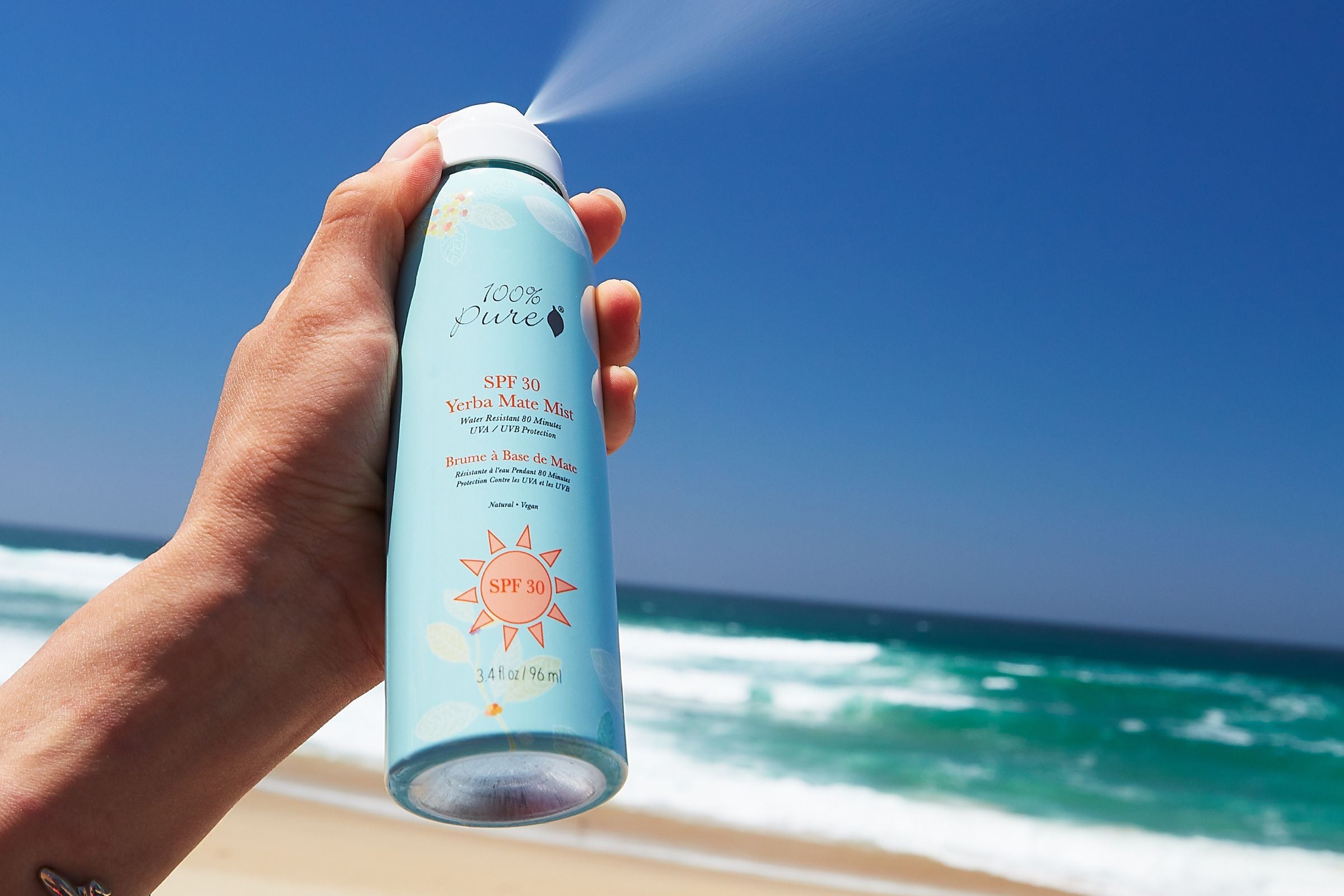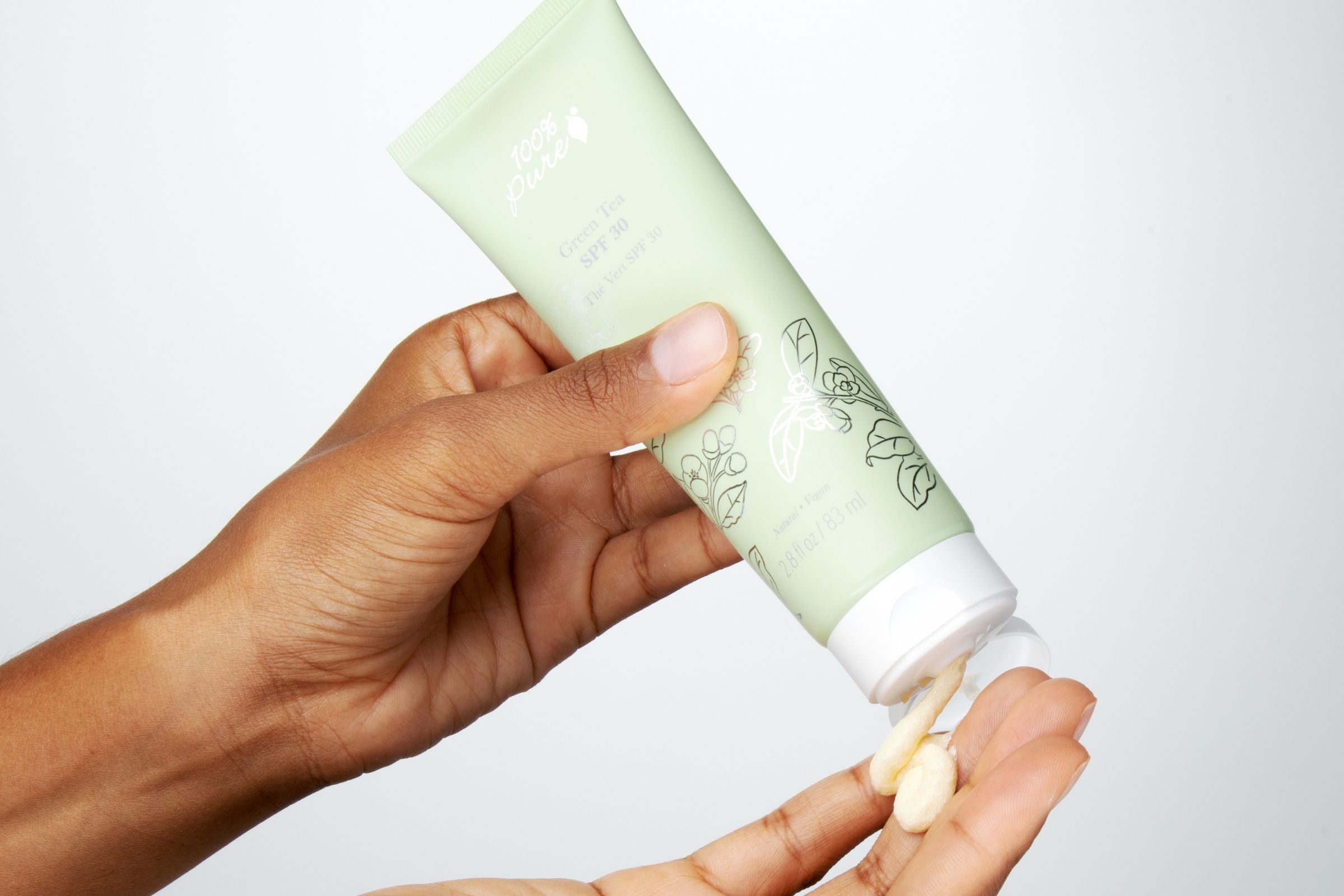Your Guide to Choosing a Sun Protector That's as Natural as You Are
Written by: 100% PURE ®
If we could shout its importance from the rooftop, I scream, you scream, we all scream for sunscreen – and, of course, ice cream!
While your stance on the significance of sun protection may be slightly less dramatic, you’re likely most privy to the drama surrounding using sunscreen during the winter. We know it seems like an odd time of the year to focus on sun protection, but skin needs sunscreen year-round.
And just like not all ice cream is made equal, not all SPF is created equal – or even healthy! Thankfully, there's been an upshift towards natural alternatives, driven by concerns about the potential health risks and the environmental impact of chemically laden sunscreens. This shift signifies a growing awareness of the need to protect our skin and the planet simultaneously.
We can’t agree more, and that’s where our Earth-friendly natural sunscreens come in to sweeten the deal on wearing sun protection year-round. Let’s delve into the benefits, and application tips, and answer all your burning questions about sunscreen. Whether it’s summer or winter, it’s always the right time for natural sunscreen – and ice cream!
Like a double-edged circle, the sun provides many advantages – say, life on Earth wouldn’t exist, for starters. But unfortunately, it has its health and skin disadvantages for us planet dwellers who don’t regularly wear adequate sun protection. Sunscreen is meant to protect your skin from the sun’s harmful rays, and it’s hard to emphasize how important this one product is for your delicate dermis.
Sunscreen specifically shields your skin from the ultraviolet (UV) rays, which consist of UVA rays that are most associated with long-term aging of the skin, and UVB (burning) rays, which are attributed to sunburn. UVA light penetrates all levels of the skin, from the epidermis down to the dermis. This damaging light can affect the collagen and elastin fibers that keep your skin smooth and plump.
If UVB light reaches the epidermis; it can cause photoaging, damage DNA, and trigger the formation of precancerous cells as well as excess melanin production. Melanin is a pigment that’s meant to protect the skin from the sun’s rays, but it results in the appearance of dark spots, popped blood vessels in the skin, sunburns, premature aging, and an increased risk of skin cancer.
Now that we know about the importance of broad-spectrum protection, what about the meaning of all those numbers on sunscreen products?
The Sun Protection Factor (SPF) rating measures the level of UVB protection a sunscreen provides. This number is supposed to signal how much longer it takes your skin to burn while using that sunscreen properly. With an SPF 30 sunscreen, as an example, your skin would take 30 times longer (than it would unprotected) to develop a sunburn while exposed to UV rays.
This alone should tell you that your skin type plays a factor in what kind of SPF rating you need: if you have delicate skin (as babies do) or fair skin, you’re likely to burn faster than someone with darker or more weathered skin, which would mean you’d need a higher SPF rating to stay in the sun for longer. Therefore, it’s important to consider two things when determining your SPF needs: first, duration of sun exposure, and second, your skin type.

If you’ve been mindlessly applying a conventional sunscreen for years, it’s time to take a closer look at those chemical ingredients versus the mineral ingredients often found in safer natural sunscreens. In the quest for healthier skin and a healthier you, it’s important to understand how chemical sunscreens, which are often conventional formulas, differ from physical sunscreen, which mainly categorizes mineral or natural sunscreens.
Chemical or conventional sunscreen works by absorbing the sun’s UV rays with chemicals. That’s right, these chemicals are reacting with UV rays right on your skin’s surface, and are turned into heat that is then released from your skin. This can spell bad news for sensitive skin types. This chemical and heat reaction can also irritate skin and trigger the formation of dark spots or worse, these harmful chemicals can pose many health risks.
As opposed to chemical sunscreens, physical sunscreens work by physically blocking (instead of reacting with) UVA and UVB rays. You might also see it called ‘mineral sunscreen’ because it uses minerals like zinc oxide and titanium oxide as physical shields against UV rays. Because mineral sunscreens shield your skin against UV rays, you can eliminate the potential of harmful chemical reactions and irritation – and a UV biggie, fewer health risks. Moreover, mineral formulas are eco-friendlier!
Most conventional formulas use chemical sunblocks. These will typically contain a combination of oxybenzone, avobenzone, octisalate, octocrylene, homosalate, and octinoxate. These chemical combinations can mimic hormones when absorbed into the bloodstream and interfere with the body’s endocrine system. They’re designed with “absorption enhancers” that make molecules small enough to enter your deepest epidermal layers. This points to various health risks, ranging from hormonal and thyroid disruption to increased risk of certain types of hormonal cancers.
The toxic traits of chemical sunscreens don’t just stop at the potential for adverse skin and health risks. Another big problem with chemical sunscreens is how they affect the environment. That’s right! These chemical culprits cause harm to marine ecosystems and coral reefs. How so? Chemical or conventional sunscreens don’t just stick to your skin when you jump into the ocean or other bodies of water.
As you’re splishing and splashing around, your sunscreen is gradually slipping off your skin (that’s why you should always reapply after swimming). So where does that sunscreen go? If you’re wearing chemical sunscreens that contain oxybenzone or octinoxate, you’re carrying these harmful chemicals right into the water with you. The runoff from chemical sunscreens we wear while swimming has damaged natural ecosystems and wildlife that live in oceans, rivers, and lakes. Each year, 6,000-14,000 tons of sunscreen enter the ocean, endangering and even killing delicate coral reef ecosystems.
Why risk the potential of skin and health adverse effects – plus harming the ocean which helps feed us - when you can get an effective, wholesome alternative to chemical variants? Your health and the environmental implications are not worth it!
So, let’s look through the benefits of natural, mineral-based sunscreens for both healthy skin and happy sea life. They work by physically blocking (instead of reacting with) UVA and UVB rays. You might also see it called ‘mineral sunscreen’, because it uses minerals like zinc oxide and/or titanium oxide as physical shields against UV rays, instead of being absorbed into the skin. This eliminates the potential for harmful chemical reactions and irritation to your delicate dermis.
Our natural sunscreens help keep skin youthful, protected, and hydrated with a powerful blend of plant-derived nutrients, oils, and vitamins. The perfect percentage of zinc oxide and titanium dioxide means safe protection against harmful UVA and UVB rays. That’s quite a burden of responsibility on mineral sunblocks’ shoulders to protect our skin from harmful UVA and UVB rays, especially when it comes down to relying on zinc oxide and/or titanium oxide. Let’s just say these minerals are natural at it.
Zinc oxide is one mineral skin protectant that can be incredibly effective at keeping your epidermis shielded from UV rays. It’s derived from zinc, a naturally occurring element found in nature, which is combined with oxygen molecules and vaporized to create the final composition. Together, the elements produce a fine white powder, which when applied topically, coats the outer layer of your skin, protecting it from elemental stress and oxidative damage.
The result? We have an effective, naturally derived ingredient, which provides broad-spectrum protection from sunburns and a decreased risk of skin cancer. Another benefit of zinc oxide is it’s safe to use on photosensitive and sensitive skin. Natural sunscreens made with zinc oxide as their key sunblock ingredient are also considered reef-safe!
Titanium dioxide is another skin-loving mineral option that can sometimes be found paired with zinc oxide in natural sunblock formulas. But before titanium dioxide is made into sunscreens, it is first micronized. And after the micronized process, titanium dioxide doesn’t penetrate the skin. That means that you’re getting all the sun protection benefits without the UV risks and burns.
As an active mineral ingredient, titanium dioxide sits on the outermost layer of your skin, providing a physical barrier that adequately protects against both UVA and UVB rays. However, if you plan on swimming in natural bodies of water, it’s best to avoid titanium dioxide since it isn’t considered reef-safe and has a tougher time biodegrading. Still, you’ll be just fine using sunscreens with natural titanium dioxide in the pool or during outdoor activities.
Newsletter Subscribe
for more blog updates and exclusive discounts

When it comes to our natural sunscreens, we go the extra mile. We’re not just protecting you from the sun. Our natural sunscreens work full duty to keep your skin protected and hydrated with a powerful blend of natural ingredients, soothing oils, and essential vitamins. We include pure botanical elements in all our sunscreens, from green tea to tomato lycopene, to help address any skin concerns.
The perfect percentage of zinc oxide and titanium dioxide means safe protection against harmful UVA and UVB rays. All our natural sunscreens are noncomedogenic, and fragrance and preservative-free, so you can wear them under or over makeup and reapply them throughout the day, without worrying about clogging your pores or irritating your skin type. Here are some top picks!
This natural sunblock pulls double duty, with its protective and anti-aging properties of green tea, plus powerful antioxidant benefits from vitamin E to neutralize free radicals and environmental damage. It’s made in a base of hydrating aloe and skin-soothing cucumber juice, with nourishing oils of raspberry, avocado, olive, and rosehip to soften and moisturize skin for comfortable all-day wear and sun protection.
Protection: SPF 30
Vegan: Yes
Contains Titanium Dioxide: No
Contains Zinc Oxide: Yes
Water Resistant: Yes
Type of Formula: Lotion
Find your perfect mate with this lightweight mist made with nourishing yerba mate. Like our fave green tea, yerba mate leaf is antioxidant-rich for protection against free radicals that cause UV damage and signs of premature aging. Safflower seed oil has a light floral scent that also soothes and conditions your skin. This reef-safe natural sunscreen spray has an application that’s easy to apply on the fly, and we use a compressed air canister built into the bottle to eject the formula, instead of ozone-harming CFCs.
Protection: SPF 30
Vegan: Yes
Contains Titanium Dioxide: No
Contains Zinc Oxide: Yes
Water Resistant: Yes
Type of Formula: Spray
Using sunscreen properly is a must for dodging serious side effects like burnt skin, dark spots, and skin cancer. Whether it’s sizzling hot or cloudy outside, fall or winter, be sure to use sun protection daily. Our natural sunscreens will provide the sun protection and skin nourishment you’ll need year-round, to ensure you’re enjoying super-safe fun outdoors. But there are some important tips to maximize your protection.
Protective Application & Measures: You’ll need to follow a strict sunscreen regimen anytime your plans include being outdoors. That means wearing at least an SPF 30 even on cloudy days. Don’t forget key areas of the body to apply sun protection.
Reapplication & Sun Safety Tips: Be sure to reapply sunscreen after swimming and sweating, and reapply again at least every 2 hours. And of course, don’t forget UV protective sunglasses, a wide-brimmed hat, an umbrella, and protective clothing for extra protection from the sun!
Daily Routine with SPF: Layering sunblock with other natural skincare products in your daily routine is easy and can provide maximum skin-efits for your skin.
Hydration Post Sun or Clouds: It’s important to keep your skin hydrated always, whether it’s after fun in the sun or outdoor winter wonderland activities. The following products tick all the boxes for hydrating and soothing skin – and more!
Black Tea Grass Jelly Anti-oxidant Serum
Boost skin's defense against free radicals and aging with our concentrated antioxidant serum. Infused with Puerh Black Tea Leaves, this formula plumps, and firms your skin while efficiently absorbing to hydrate and nourish it. Experience the perfect base for flawless makeup application as you indulge in the ultimate skin protection and nourishment.
Black Tea Grass Jelly Anti-oxidant Moisturizer
If you like the serum packed with the benefits of black tea and grass jelly, you’ll love pairing it with our silky smooth, super-hydrating moisturizer! Formulated to sink deep into the skin, this moisturizer combats signs of aging by nourishing skin with powerful hydration and beneficial antioxidants so skin looks firmer, brighter, and more youthfully radiant.
Honey Almond Nourishing Body Cream
This luxuriously creamy body lotion is enriched with potent anti-aging vitamins and antioxidants for softer, more supple skin. Deeply moisturizing cocoa and avocado soothe dryness and flaking, while aloe and rose hydrosol replenish essential hydration. Additions of stimulating Kona green coffee and vitamin C brighten and energize the skin for a more youthful glow. This silky-smooth body cream is infused with the scent of sweet, honey-glazed almonds.
What Makes a Sunscreen 'Natural'?
If it contains natural ingredients and not harmful chemicals that can be absorbed into the skin like chemical sunscreens. The only active ingredients in a natural sunscreen are the naturally occurring minerals zinc oxide and/or titanium dioxide. Natural sunscreens can also contain plant-derived oils, vitamins, and nutrients to nourish and hydrate skin.
How Often Should I Reapply Natural Sunscreen?
Natural sunblock is, unfortunately, not effective all day long and will degrade (break down and become less effective) the longer you wear it. A best practice is to apply it every 90 minutes to 2 hours, at least 15-30 minutes before going outside. If you’re swimming or sweating, reapply it immediately after rinsing off or towel-drying. You’ll need to follow a strict sunscreen regimen anytime your plans include being outdoors. That means wearing at least an SPF 30 even on cloudy days, reapplying after swimming and sweating, and reapplying again at least every 2 hours.
Can Natural Sunscreen Provide Enough Protection for Beach Days?
Yes, natural sunscreens work by physically blocking (instead of reacting with) UVA and UVB rays. Minerals like zinc oxide and titanium oxide act as physical shields against rays that cause sunburn. It’s important to reapply sunscreen, especially after water activities. Protective clothing and seeking shade when possible are some other best measures to keep your skin safe during long beach days.
Is Natural Sunscreen Safe for Children?
Natural sunscreens are more kid-friendly than other standard sunblocks. Still, it is advisable to always check labels for child-specific products. See if it has gentle, hypoallergenic formulations and higher SPF levels for young, delicate skin.
How Do I Choose a Natural Sunscreen for Different Outdoor Activities?
First, make sure the sunscreen formula has broad-spectrum protection with at least an SPF of 30. When you’re going swimming or doing other outdoor activities where you could get wet, you should use a water-resistant sunscreen. Look for sweat-resistant and non-comedogenic formulas when you’re doing physical activities. Sunscreen formulas that are lotions are great for everyday wear, while natural sunscreen mists are ideal for sports and outdoor activities. Body sun protection sticks work well for time spent on the water.
A great sunscreen is only as good as what’s in it and how you use it. When it comes to sun protection, we’ll shout from the rooftop again about the praises of physical or mineral sunscreens. Their natural, mineral-based formulas are safer for your skin and health and kinder on the planet.
Chemical sunscreens, on the other hand, use harmful ingredients like oxybenzone. These chemicals can lead to health-related issues, and contribute to coral bleaching in our oceans – a huge problem for aquatic life.
In addition to adopting a holistic approach to sun protection, it’s also effective to combine natural sunscreens with physical barriers like hats and shade. It provides a comprehensive defense against UV radiation. Remember, using natural sunscreen cares for your skin and contributes to environmental preservation.
When you opt for a natural sunscreen, your whole skin regimen is going to work better in the short and long run. Whether it’s 10 or 20 years from now, your skin and health will thank you for the protection. Plus, wearing a natural sunscreen year-round could improve your skin’s health. We’d have to say that would sweeten the deal with a cherry on top. It makes for a great sundae on a sun (or winter) day!
- Tags: December-2023, Skin Care, skincare
We carefully hand-select products based on strict purity standards, and only recommend products we feel meet this criteria. 100% PURE™ may earn a small commission for products purchased through affiliate links.
The information in this article is for educational use, and not intended to substitute professional medical advice, diagnosis, or treatment and should not be used as such.







